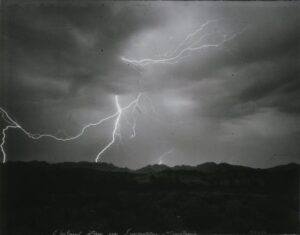Portraits of Sky: Selections from the Permanent Collection
Audio Guide
Introduction
Audio Recording
Portraits of Sky: Selections from the Permanent Collection
Ever-present, the sky hugs earth and serves as the backdrop to our world. Early morning mist; stark-blue skies; electric-pink sunsets; black, silent, star-filled nights—in all its shifting forms—the sky is reassuringly there while simultaneously reflecting the temporary realities of our lives back upon us. Portraits of Sky investigates our fascination with the world above, through artist illuminations of clouds, stars, and the sky in its transitory splendor. Created over a hundred-year period from the 1920s forward, the artworks range in style from the graphic Pop Art of Roy Lichtenstein to the delicate woodcuts of Vija Celmins. Some of the artists pay homage to mother nature, by capturing their visions of her beauty in paint, pastels, photographs, and clay, while others emphasize clouds and stars as symbols for contemporary, environmental, and social promises. The artists use their unique creative practices to accentuate the world above, by freezing a moment of fleeting existence for our everlasting enjoyment.
Organized by the Boise Art Museum
Jeffry Mitchell, Cloudy Windy Rainy Today Stars Tonight Umbrella Stand, 2023
Audio Recording
Jeffry Mitchell
(b. 1958, Seattle, WA)
Cloudy Windy Rainy Today Stars Tonight Umbrella Stand, 2023
glazed stoneware
Boise Art Museum Permanent Collection
Purchased with funds donated by Kay Hardy and Gregory Kaslo
Jeffry Mitchell, a self-described, gay folk artist, creates playful ceramic sculptures that embrace a nostalgia for childhood. In Cloudy Windy Rainy Today Stars Tonight Umbrella Stand, Mitchell uses language, conventionally heard in weather reports, as decorative text on the surface. One side speaks of days of sunshine to come, the other, of today’s rain and clouds. Miniature elephants, bears, and butterflies climb and play on the artwork, reiterating its positive message, that tomorrow will be a better day.
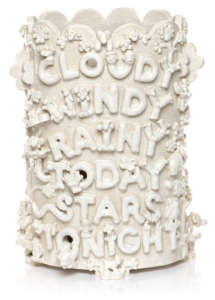
Bruce Park, Reverse Clouds, 1989
Audio Recording
Bruce Park
(b. 1955, Sacramento, CA)
Reverse Clouds, 1989
pastel on paper
Boise Art Museum Permanent Collection
Gift of Clark and Sydney Fidler
“The landscape is now my mentor and even after thousands of paintings it still is an adventure into the light, beauty, and awe with each new painting.”
Reverse Clouds turns our world up-side-down and offers a sky reflected in water. The artist grounded the drawing with a crimson red underlayer and allowed small sections to peek through, giving the artwork its richness and depth. By mirroring the clouds in the landscape and the sky, Park cleverly devotes the entire composition to the depiction of clouds, traditionally only shown in the top half of a landscape drawing.
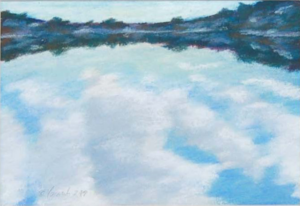
Maynard Dixon, Skies of New Mexico #18, 1931
Audio Recording
Maynard Dixon
(1875-1946, Fresno, CA)
Skies of New Mexico #18, 1931
oil on board
Boise Art Museum Permanent Collection
Gift of Wilfred Davis Fletcher for BAM’s 75th Anniversary
Maynard Dixon is well known as a premier painter of the American West. Skies of New Mexico #18 was made during a central period in his career, when he began pushing the horizon line to the bottom of his compositions and simplifying pictorial detail to create a more modern aesthetic.
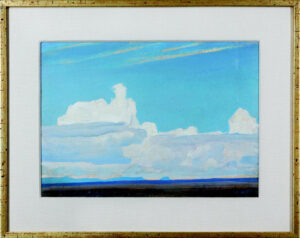
David Hendricks, Popham Beach Sunset, 1984
Audio Recording
David Hendricks
(b. 1948, Hammond, Indiana)
Popham Beach Sunset, 1984
colored pencil on paper
Boise Art Museum Permanent Collection
Purchased with funds provided by Glenn C. Janss and the Janss Foundation
Popham Beach Sunset, is a marvel of colored pencil done in large scale, atypical of a medium which lends itself to small detail and size. Hendricks deftly creates a striking, unified image, built of thousands of small colored pencil marks. Within these marks he captures the golden hour’s last strong bursts of sunlight, the moment when land is on the precipice of shifting into inky blackness against the sky.
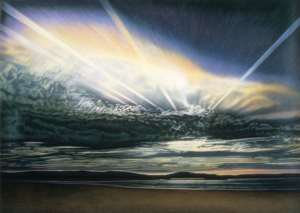
Troy Dalton, Color Meditation/Land 83-88, 1988
Audio Recording
Troy Dalton
(b. 1952, Sweetwater, TX)
Color Meditation/Land 83-88, 1988
acrylic on canvas
Boise Art Museum Permanent Collection
Troy Dalton produced this painting while in graduate school, at the University of California, Davis. It is a rare landscape, made before he shifted to the figure, a focus that has dominated his artistic career. Soft, murky, Rothko-like blending simultaneously depicts cloud formations and celebrates abstraction at its finest. Dalton avoids the use of line, expertly arranging swaths of thin, scumbled colors that drift into one another to define shape and form. The artwork’s scale bypasses our peripheral vision and places us inside the experience of storm clouds rolling across mountains.
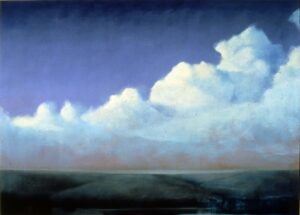
Victoria Adams, Twist, 2006
Audio Recording
Victoria Adams
(b. 1950, Columbus, OH)
Twist, 2006
oil on linen
Boise Art Museum Permanent Collection
Gift of Gail Severn Gallery
Victoria Adams’ landscape paintings are part of a long tradition—from European masters through to Hudson River painters—that gives prominence to respect for the natural landscape. Her glowing, highly rendered, realistic paintings are composite locations joined together from small bits of personal photographs and her memory of land that was once untouched by human development. These paintings pay tribute to the nature of our past, the sky, and a pure, unmarred earth.
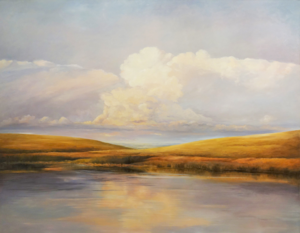
Roy Lichtenstein
Audio Recording
Roy Lichtenstein
(1923-1997, New York, NY)
left – right:
Landscape 3, 1967
Landscape 5, 1967
Landscape 4, 1967
Landscape 1, 1967
screen print
Boise Art Museum Permanent Collection
Gift of Allan P. and Lenore B. Sindler
Beginning in the 1960s, Pop-Art founder, Roy Lichtenstein drew inspiration for his first landscape compositions from nature scenes in the backgrounds of comic strips, printed on newsprint with ben day dots. Ben day dots were developed in the late 19th century as a printing method to create shading and colors in images commonly seen in newspaper cartoons. Lichtenstein was not concerned with capturing the beauty of the natural environment. Instead, he chose to portray scenes from nature in a way that made them appear mass-produced. His images were meant to be reminiscent of travel postcards and often referenced art historical masterpieces. While appearing photo-mechanically produced or computer-generated, his dotted landscapes—using the simplified forms of land and sky as a playground for color, pattern, and perception— were handmade. These four artworks—Landscape 1, 3, 4, and 5—are part of a series of ten prints the artist made between 1964 and 1976 in which he emphasized material experimentation and pictorial abstraction.
Gregory Lomayesva, Kachina Wearing Rain Cloud Tableta, n.d.
Audio Recording
Gregory Lomayesva
(b. 1971, Santa Fe, NM)
Kachina Wearing Rain Cloud Tableta, n.d.
pine, macaw feathers, straw, and acrylic
Boise Art Museum Permanent Collection
Gift of Joan H. and John B. Carle
“I don’t identify myself too much with either culture (his mother is Hispanic and his father is Hopi) because I don’t want to be pigeon-holed. I think that doing art based on ethnicity limits the playing field, so I try to express myself as an artist whose playing field is the world.”
Gregory Lomayesva is a self-taught artist who makes mixed-media sculptures inspired by, but not representative of, Kachina figures. In Kachina Wearing Rain Cloud Tableta, a rain-cloud image rests behind the figure’s portrait, as a sign of the sky’s importance to the identity of the Kachina spirit. Traditional Hopi Kachina are spirit beings in Pueblo religion. To the Hopi, Hopi-Tewa, Zuni, and some Keresan Tribes, Kachina are personifications of things in our real world.

Steven Heinemann, Event Horizon #2, 2011
Audio Recording
Steven Heinemann
(b. 1957, Toronto, Canada)
Event Horizon #2, 2011
slip cast earthenware with glazes
Boise Art Museum Permanent Collection
Purchased with funds donated by the A. Kay Hardy and Gregory A. Kaslo Philanthropic Gift Fund in the Idaho Community Foundation
Event Horizon #2 focuses its attention skyward, through both its swelling form and its surface design. Heinemann’s clouds are caught in motion on the vessel’s surface, while the matte-black glaze becomes a dark night sky. Layered over his white clouds, horizontal, thread-like bands suggest clotheslines or delicate power lines strung through the sky. The artwork embodies its subject so fully that we can almost feel clouds within the sculpture’s belly.
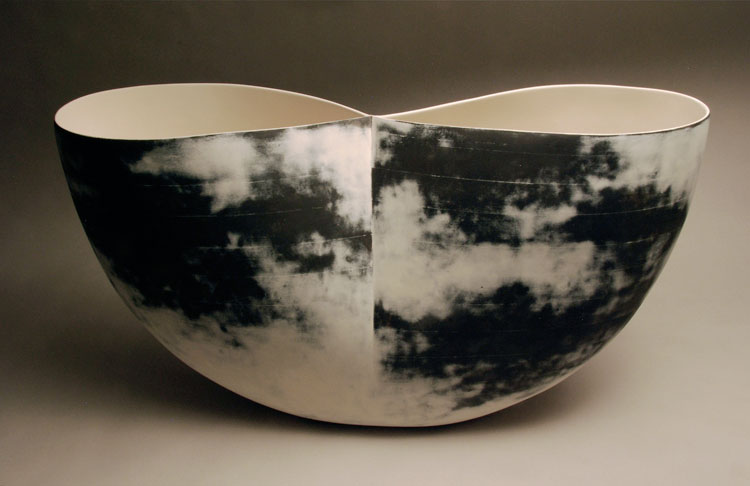
William Beckman, Power Lines, 1982
Audio Recording
William Beckman
(b. 1942, Maynard, MN)
Power Lines, 1982
pastel on paper
Boise Art Museum Permanent Collection
Purchased with funds provided by Glenn C. Janss and the Janss Foundation
William Beckman, a prolific maker, creates paintings and drawings depicting imagery ranging from farms and portraits of bulls, to self-portraits and bathers in the sea. Raised in rural Minnesota, Beckman first saw an original painting at age 19. He describes this moment as the catalyst for deciding to become a painter. When discussing his landscape paintings, he emphasizes the importance of the land being an active farm, “The land has to have been worked.”
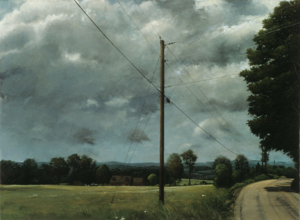
Paul Otero, Sangre de Cristo Mountains: New Mexico, 1986
Audio Recording
Paul Otero
(b. 1950, Denver, CO)
Sangre de Cristo Mountains: New Mexico, 1986
graphite on paper
Boise Art Museum Permanent Collection
Gift from the Collection of Glenn C. Janss
Of his photorealistic renderings, Otero has said that he wants to capture, “the essence, the feel, and the soul of an image.” This intricate drawing becomes a portrait of the New Mexico sky by recording the range of its emotional expressions, including serenity, wonder, and awe, and memorializing its fleeting state as the clouds pass by.
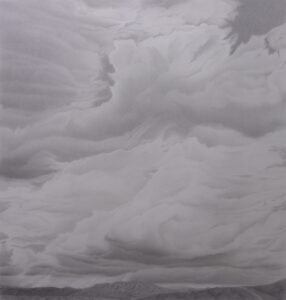
Claire Van Vliet, Grey Clouds, 1975
Audio Recording
Claire Van Vliet
(b. 1933, Ottawa, Ontario)
Grey Clouds, 1975
lithograph, edition XIX/XXV
Boise Art Museum Permanent Collection
Gift of Dr. & Mrs. Christopher A. Graf and Dr. & Mrs. Frederick P. Nause
Claire Van Vliet is known for her long career of creating artist books and her innovative use of dyed paper pulp. She founded Janus Press, where she publishes collaborative works by papermakers, printmakers, and contemporary artists and writers. Recognized as a master printmaker, Van Vliet’s artwork often incorporates imagery from nature and the landscape, which she attributes to the daily walks she took in the English countryside as a child.
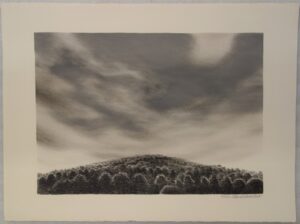
George K. Brandriff, Rising Clouds, 1931
Audio Recording
George K. Brandriff
(1890-1936, b. Millville, NJ, d. Laguna Beach, CA)
Rising Clouds, 1931
oil on board
Boise Art Museum Permanent Collection
Gift of Wilfred Davis Fletcher
George Brandriff was a self-taught artist who focused on beach scenes, marinas, and mountain landscapes. This diminutive painting has a prominent presence created by the use of a dynamic diagonal horizon line, in the bottom quarter of the composition, and a dominant sky with billowing blue clouds, in the top three-quarters of the canvas.

Ernest Albert, Clouds, n.d.
Audio Recording
Ernest Albert
(1857-1946, Brooklyn, NY)
Clouds, n.d.
oil on canvas board
Boise Art Museum Permanent Collection
Gift of Wilfred Davis Fletcher
Landscape painter, muralist, and set designer, Ernest Albert created many of his works in Old Lyme, Connecticut, and Monhegan Island, Maine. Quiet, rural scenes, such as this one, were his favorite subject matter. In this painting, he focused on animating the interaction between the wind and leaves of trees. We can almost hear the leaves rustling in the breeze.
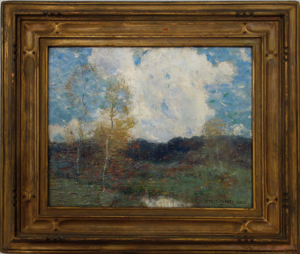
Vija Celmins, Night Sky Woodcut, 1997
Audio Recording
Vija Celmins
(b. 1938, Riga, Latvia)
Night Sky Woodcut, 1997
woodcut mounted on paper, A/P edition 5/20
Boise Art Museum Permanent Collection
Gift of M. Gary Bettis
Vija Celmins spends up to three years making a single woodcut, laboring over each star’s placement, size, and detail to re-create the experience of a sparkling night sky. Celmins began making still-life drawings and paintings during the height of the Pop Art Movement and has evolved her practice to make meticulous renderings of detailed, yet minimalistic landscapes, including stars in the night sky, vast stretches of ocean, and open deserts. As is the case with most of the artist’s drawings, prints, and paintings, Night Sky is based on astronomical imaging, rather than direct observations of the sky.
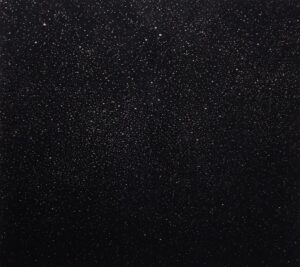
Rhondal McKinney, Untitled (Dark Field), 1981
Audio Recording
Rhondal McKinney
(b. 1948, Southern IL)
Untitled (Dark Field), 1981
gelatin silver print,
edition 6/25
Boise Art Museum Permanent Collection
Gift of M. Gary Bettis
A dance between light and dark, land and sky, soft- and hard-edged, Untitled (Dark Field) idolizes the flat, vast expanse of the American plains. Equally juxtaposing the rounded forms of white, cumulous clouds against the geometric, straight rows of crops, McKinney calls attention to the reliance of American’s farming community on land and sky.
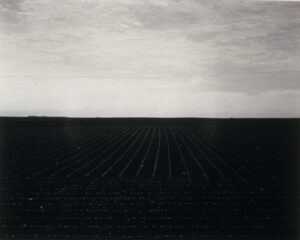
Harrison Groutage, Franklin Hill, 1960
Audio Recording
Harrison Groutage
(1925-2013, Richmond, UT)
Franklin Hill, 1960
tempera on panel
Boise Art Museum Permanent Collection
“I don’t sit down and copy nature. I dramatize it. I celebrate it.”
A pivotal Utah artist and teacher of generations of Utah State University art students, Groutage made this artwork when he was in graduate school at Iowa State University. In Franklin Hill, he places the viewer in shadow, looking out into a valley, a witness to a vast sky filled with an impending storm. The land and its inhabitants below seem small against the strength of the storm, emphasizing our frailty in the face of nature.

Edgar Payne, Storm in Arizona, 1920
Audio Recording
Edgar Payne
(1883-1947, Barry County, MO)
Storm in Arizona, 1920
oil on canvas
Boise Art Museum Permanent Collection
Gift of Wilfred Davis Fletcher
Edgar Payne’s assertive, bold, mark-making and color palette suggest this artwork was made in one sitting, utilizing the direct-painting method, in which an artist layers paint wet-on-wet with minimal blending. The plateau stands sturdy within a storm of hard rain. A large shadow covers the landscape with a small dapple of light on the red rock in the distance, creating a composition that invites the viewer into the foreground, middle ground, and then background.

Artist Unknown, Japanese Kimono, 1930
Audio Recording
Artist Unknown
Japanese Kimono, 1930
various textiles
Boise Art Museum Permanent Collection
Gift of Elton and Katherine Hall
In Japan, clouds are widely recognized as lucky omens. Their relationship to good luck stems from the belief that spirits or demigods live within the clouds, where they wield power over the weather. Due to the farming communities’ dependence on rain for their crops, clouds and their spirits became revered throughout Japan. In this kimono, soft white clouds float behind embroidered flowers, emphasizing the entwined relationship between the weather and successfully nurturing life. The scattered flowers span an array of varietals, each with a specific, deep meaning in Japanese culture, from the Japanese Peony which symbolizes bravery and honor, to the lotus that serves as a signifier for enlightenment and purity.
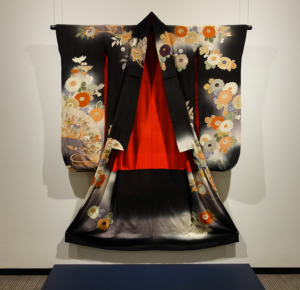
Keith Jacobshagen, Frozen Pond Near Walton, 1983
Audio Recording
Keith Jacobshagen
(b. 1941, Witchita, KS)
Frozen Pond Near Walton, 1983
oil on paper
Boise Art Museum Permanent Collection
Gift of Glenn C. Janss
Keith Jacobshagen’s muse is the sky and earth of Kansas. He captures the vastness of the land by focusing attention on the sky and devoting much of the composition to its presence. This abstract landscape, in fractured shapes of blue and orange, reflects the sun’s warmth and the water’s frozen surface.
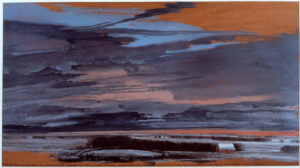
Chris Jordan, Toothpicks, 2008
Audio Recording
Chris Jordan
(b. 1963, San Francisco, CA)
Toothpicks, 2008
pigmented inkjet print,
edition 2/6
Boise Art Museum Permanent Collection
Collectors Forum Purchase, 2010
In Toothpicks, one-hundred-million toothpicks, equal to the number of trees cut down in the United States every year to make paper for junk mail, are presented under a vast, outstretching sky. The infinite sky emphasizes the monumental number of felled trees and the enormity of the problem, while also referencing the natural environment we want to preserve.
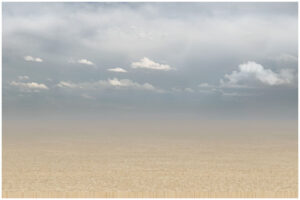
Hilary Brace, Untitled (March #1 ’93), 1993
Audio Recording
Hilary Brace
(b. 1956, Seattle, WA)
Untitled (March #1 ’93), 1993
pastel on paper
Boise Art Museum Permanent Collection
Gift of the Artist
Hilary Brace’s highly rendered cloudscapes are created strictly from the artist’s imagination, with no photographic reference material. Brace utilizes the cloud form as a signifier to slow down and consider the instability and fleeting nature of our own existence. This thought is presented by the artist as a source of comfort, “As swiftly as a cloud passes through the sky, our existence and the world can change. Be present; you never know what the day will bring.”
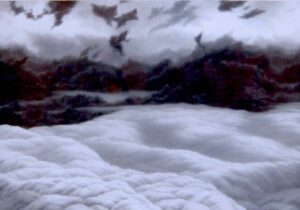
Toshio Shibata, Grand Coulee Dam, Douglas County, WA, 1996
Audio Recording
Toshio Shibata
(b. 1949, Tokyo, Japan)
Grand Coulee Dam, Douglas County, WA, 1996
gelatin silver print
Boise Art Museum Permanent Collection
Collectors Forum Purchase, 1999
Japanese photographer Toshio Shibata’s sublime, highly detailed portraits of public-works projects capture the complex relationship between human infrastructure and the natural landscape. With an objective viewpoint, Shibata highlights the visual harmony and massive scale of places where human development and nature intersect.
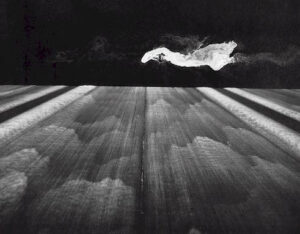
Udo Claassen, Delta, 1985
Audio Recording
Udo Claassen
(b. 1948, Itzehoe, Germany)
Delta, 1985
mezzotint, edition 73/85
Boise Art Museum Permanent Collection
Gift of M. Gary Bettis
Udo Claassen made Delta after visiting Iceland, in 1985. This artwork shows reverence for the sky, with clouds twisting and swirling through the dominant space within the composition.
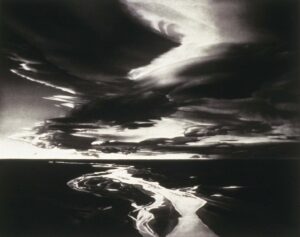
Mark Klett, Electrical Storm Over Superstition Mountains, Arizona, 1986
Audio Recording
Mark Klett
(b. 1952, Albany, NY)
Electrical Storm Over Superstition Mountains, Arizona, 1986
gelatin silver photograph, edition 12/50
Boise Art Museum Permanent Collection
Gift of M. Gary Bettis
Mark Klett was a geologist before turning to art and teaching photography at Arizona State University. Arizona’s Superstition Mountains is a spot where photographers frequently flock for dramatic views of lightning strikes. In this photograph, Klett captures mother nature’s skies with her violently flashing bursts of energy from within giant thunderheads above the massive geologic formation. The black-and-white format makes the light show especially vivid when contrasted against the black rock.
